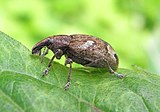Common three-flawed weevil
| Common three-flawed weevil | ||||||||||||
|---|---|---|---|---|---|---|---|---|---|---|---|---|

Common three-flawed weevil |
||||||||||||
| Systematics | ||||||||||||
|
||||||||||||
| Scientific name | ||||||||||||
| Graptus triguttatus | ||||||||||||
| ( Fabricius , 1775) |
The common weevil ( Graptus triguttatus , syn .: Alophus triguttatus ) is a beetle from the family of weevils and the subfamily Entiminae . It occurs in Europe in three subspecies ( inversus , triguttatus and wau ). The species is not easily distinguishable from similar species even on genital examination .
The scientific generic name Graptus is from Altgr. γραπτός graptós , " scratched , written" derived. This may refer to the deeply incised penultimate tarsal limbs (Fig. 3), possibly to the drawing of the wing covers . The former genus name Alophus is from Altgr. a, negation, and λόφος lóphos "neck" derived and refers to the very small label . The species name triguttātus, a, um ( Latin ) means "with three drop spots" and describes the drawing of the wing covers. This also applies to the German name Dreimakelrüssler, the "weevil (weevil) with three flaws (spots)".
Characteristics of the beetle
The body length varies between 5.7 and 10 millimeters. The diversity of the scales with which the various parts of the skeleton are covered is unusual (Fig. 4). On the pronotum , the scales are usually narrow and elongated, pointed, rarely short oval. Much longer and narrower, short pine needle-like scales are interspersed (Fig. 4 left). The scales on the elytra are circular to oval, in between there are individual long, pointed scales similar to those of the pronotum, but upright (Fig. 4 right; the upright scales white). Only such white erect scales are found on the label (Fig. 4 center, above pronotum, below elytra). The scales are colored in different shades of brown, the whitish spots are also formed by the corresponding coloring of the scales.
The mouthparts lie on an extension of the head forward, the trunk. The trunk is moderately angular, significantly longer than it is wide, slightly curved downwards and a little wider at the front. On the top it has a shallow central channel (Fig. 2). The groove in which the antennae can be inserted is on the side of the trunk and can only be seen from above to a small extent in the front area (Fig. 2). To the rear, the antennae furrow is initially sharply delimited and runs, slightly lowering, towards the lower edge of the eyes, where it disappears (Fig. 1). The eyes are on the side of the head, are slightly arched, rounded and higher than wide. The kneeling antennae consist of a shaft that extends to the front edge of the eye, a seven-limbed narrow flagellum and a four-limbed spindle-shaped club (Fig. 2).
The pronotum has a simple center line that is deepened in the front part and then shortened, or it can be completely extinguished. In the middle of the pronotum base there is a small bump or at least a bulge is indicated.
The elytra are drawn with three spots, which are usually not very prominent in color and also vary considerably in shape. They are made up of white scales and are often framed with darker scales. Each wing-cover has a spot running to the side just before the middle (central flaw), and in front of the tip a band that runs over both wing-covers and is indented in front together and behind individually. In this volume you can also recognize the Greek letter γ (gamma) and therefore a synonymous epithet is also gamma . Together the elytra are oval. Its greatest width is measured in the middle for the male and in front of it for the female. At the back the elytra are rounded together. The label is small but clearly visible (Fig. 4 center).
The cavities into which the front hips are turned are much closer to the rear edge of the front chest than to its front edge (Fig. 5). The thighs are imperforate (Fig. 5). The bare surface at the end of the rails is approximately perpendicular to the rail and is surrounded by a ring of bristles (Fig. 3). The end pin on the inside of the rail is relatively small (Fig. 3 and 5). The third (penultimate) tarsal segment is incised deeply beyond the middle and broadly lobed (Fig. 3). The claws are not fused together at the base.
biology
The biology of the species is still largely unknown. When feeding plants are Plantain , Dandelion , Eupatorium Cannabinum , Symphytum officinale and Nodding comfrey called. When trying to feed, however, the species is almost indiscriminately polyphagous . Adults were often found under stones, between moss and grass and near water, so they seem to be moisture-loving.
distribution
The distribution area is limited to Europe and divided into two parts. In the west it includes Great Britain , France , Germany , the Czech Republic , Austria , Switzerland and Italy . Hungary forms the bridge to the eastern part of the distribution area with Moldova , Ukraine and northern, eastern, central and southern Russia . The subspecies Graptus triguttatus inversus is only known from Austria. In the east of the distribution area the species is represented by the subgenus Graptus triguttatus wau .
literature
- Heinz joy , Karl Wilhelm Harde , Gustav Adolf Lohse (ed.): The beetles of Central Europe . tape 11 . Rhynchophora (end). Goecke & Evers, Krefeld 1983, ISBN 3-87263-031-8 .
Individual evidence
- ↑ a b c Graptus triguttatus in Fauna Europaea. Retrieved January 30, 2011
- ↑ Siegmund Schenkling "Explanation of the scientific beetle names"
- ↑ Polish koleopterologische site




